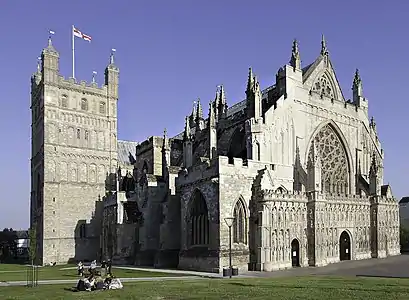Bishop of Exeter
The Bishop of Exeter is the Ordinary of the Church of England Diocese of Exeter in the Province of Canterbury.[2] The current incumbent, since 30 April 2014, is Robert Atwell.[3] The incumbent signs his name as his Christian name or forename followed by Exon., abbreviated from the Latin Episcopus Exoniensis ("Bishop of Exeter").
Bishop of Exeter | |
|---|---|
| Bishopric | |
| anglican | |
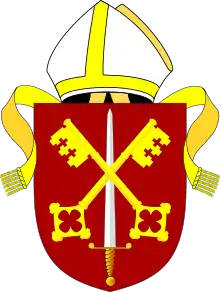 Arms of the Bishop of Exeter: Gules, a sword erect in pale argent hilted or surmounted by two keys addorsed in saltire of the last[1] | |
| Incumbent: Robert Atwell | |
| Location | |
| Ecclesiastical province | Canterbury |
| Residence | The Palace, Exeter |
| Information | |
| First holder | Werstan Leofric (first Bishop of Exeter) |
| Established | 905 (founded at Tawton) 912 (translated to Crediton) 1050 (translated to Exeter) |
| Diocese | Exeter |
| Cathedral | Exeter Cathedral (1112–present) |
From the first bishop until the sixteenth century the Bishops of Exeter were in full communion with the Roman Catholic Church. However, during the Reformation the Church of England broke away from the authority of the Pope and the Roman Catholic Church, at first temporarily and later more permanently. Since the Reformation, the Bishop and Diocese of Exeter has been part of the reformed and catholic Church of England. The bishop's residence is The Palace, Exeter.[4]
History

The history of Christianity in the South West of England remains to some degree obscure. At a certain point the historical county of Devon formed part of the diocese of Wessex. About 703 Devon and Cornwall were included in the separate Diocese of Sherborne and in 900 this was again divided, the Devon bishop having from 905 his seat at Tawton (now Bishop's Tawton) and from 912 at Crediton, birthplace of St Boniface. Lyfing became Bishop of Crediton in 1027 and shortly afterwards became Bishop of Cornwall.
Tawton
According to the Devonshire historian Tristram Risdon (died 1640), the manor of Bishops Tawton, on the right bank of the River Taw two miles south of Barnstaple in North Devon, was the earliest see (i.e. seat) of the Bishops within the Shire of Devon, when in 905:[5]
- "Edward, surnamed Senior, a nurse-father of the church, finding these western parts to want ecclesiastical discipline, by the advice of Pleymond, (sic) Archbishop of Canterbury, ordained a provincial synod and decreed that three new bishops should be consecrated, whereupon Edulph was appointed to Wells, Herstan to Cornwall and Werstan to Devon, who had here his see, where after him one only of his successors sat being hence removed to Crediton".
Parts of the Bishop's Palace survive in the fabric of Court Farmhouse, to the immediate south of the Church of St John the Baptist in the village of Bishops Tawton, the surviving corner towers and battlements of which were added in about 1800.[6] By the time of Dean Milles' Questionnaire of 1753 it had been converted into several poor tenements.[7] The large manor (which extended over the adjoining parishes of Landkey and Swimbridge[8]) remained the property of the See of Exeter until the Dissolution of the Monasteries when it was granted in 1550 by King Henry VIII, with other vast donations including Tavistock Abbey in South Devon, to his minister John Russell, 1st Earl of Bedford (1485-1555).[9] It remained a possession of the Dukes of Bedford until after 1872,[10] although the advowson of the church was retained by the See and was still in 1872 exercisable by the Dean of Exeter Cathedral.[11]
Werstan's successor appears to have been Putta (bishop 906–910), who was murdered whilst travelling from his see at Tawton to visit the Saxon viceroy Uffa, whose residence was at Crediton.[12] It is believed that Copplestone Cross, mentioned in a charter dated 947 and situated 6 miles north-west of Crediton and 22 miles south-east of Bishops Tawton, was erected in commemoration of his murder.[13]
Crediton
The Diocese of Crediton was created out of the Diocese of Sherborne in 909 to cover the area of Devon and Cornwall.[14] Crediton was chosen as the site for its cathedral possibly due it having been the birthplace of Saint Boniface and the existence of a monastery there.[15]
In 1046, Leofric became the Bishop of Crediton. Following his appointment he decided that the see should be moved to the larger and more culturally significant and defensible walled town of Exeter. In 1050, King Edward the Confessor authorised that Exeter was to be the seat of the bishop for Devon and Cornwall and that a cathedral was to be built there for the bishop's throne. Thus, Leofric became the last diocesan Bishop of Crediton and the first Bishop of Exeter.[15]
Exeter
The two dioceses of Crediton and Cornwall, covering Devon and Cornwall, were permanently united under Edward the Confessor by Lyfing's successor Leofric, hitherto Bishop of Crediton, who became first Bishop of Exeter under Edward the Confessor, which was established as his cathedral city in 1050. At first the Abbey Church of St Mary and St Peter, founded by Athelstan in 932, rebuilt in 1019, etc., finally demolished 1971, served as the cathedral.
Cathedral
The present cathedral was begun by William de Warelhurst in 1112, the transept towers he built being the only surviving part of the Norman building, which was completed by Marshall at the close of the twelfth century. The cathedral is dedicated to St Peter.
As it now stands, the cathedral is in the decorated style. It was begun by Peter Quinel (1280–1291), continued by Bytton and Stapeldon, and completed, much as it has since remained, by John Grandisson during his long tenure of 42 years.
In many respects Exeter cathedral resembles those of France rather than others found in England. Its special features are the transept towers and the choir, containing much early stained glass. There is also an episcopal throne, separated from the nave by a choir screen (1324) and a stately West front. In a comparison with certain other English cathedrals, it is perhaps disadvantaged by the absence of a central tower and a general lack of elevation, but it is undoubtedly very fine.
Organisation
The bishops of Exeter, like the general population of the diocese, always enjoyed considerable independence, and the see was one of the largest and richest in England. The remoteness of the see from London prevented it from being bestowed on statesmen or courtiers, so that over the centuries the roll of bishops possessed more capable scholars and administrators than in many other sees. The result was a long and stable line of bishops, leading to active Christian observance in the area.
The diocese contained 604 parishes grouped in four archdeaconries: Cornwall, Barnstaple, Exeter, and Totnes. There were Benedictine, Augustinian, Premonstratensian, Franciscan and Dominican religious houses, and four Cistercian abbeys.
Modern history
This wealthy diocese was forced to cede land during the reign of Henry VIII, when Vesey was obliged to surrender fourteen of twenty-two manors, and the value of the see was reduced to a third of what it had been. Vesey, despite his Catholic sympathies, held the see until 1551, when he finally had to resign, and was replaced by the Bible translator Miles Coverdale. Following the accession of Mary, in 1553, Vesey was restored, but died soon after in 1554. He was succeeded by James Turberville, the last Catholic Bishop of Exeter. Turberville was removed from the see by the Reformist Elizabeth I in 1559, and died in prison, probably in or about 1570.
Henry Phillpotts served as Bishop of Exeter from 1830 to his death in office in 1869. He was England's longest serving bishop since the 14th century. The diocese was divided in 1876 along the border of Devon and Cornwall, creating the Diocese of Truro (but five parishes which were at the time in Devon were included in this diocese as they had always been within the Archdeaconry of Cornwall). The diocese covers the County of Devon. The see is in the City of Exeter where the seat is located at the Cathedral Church of Saint Peter which was founded as an abbey possibly before 690. The current incumbent is Robert Atwell.
List of bishops
Pre-Reformation
| Bishops at Tawton | |||
|---|---|---|---|
| From | Until | Incumbent | Notes |
| c. 905 | c. 906 | Werstan | |
| c. 906 | c. 910 | Putta | |
| Bishops of Crediton | |||
| From | Until | Incumbent | Notes |
| c.909 | 934 | Eadwulf | |
| 934 | c.952/53 | Æthelgar | |
| 953 | 972 | Ælfwold I | |
| 973 | 977 | Sideman | Died on 30 April 977 or 1 or 2 May 977. |
| c.977/79 | c.986/87 | Ælfric | |
| c.986/87 | ? | Ælfwold II | |
| ? | c.990 | Alfred of Malmesbury[16] | |
| ? | c.1011/15 | Ælfwold III | |
| c.1011/15 | c.1019/23 | Eadnoth | |
| 1027 | 1046 | Lyfing | Also Bishop of Cornwall and Worcester; died in March 1046. |
| 1046 | 1050 | Leofric | Consecrated on 19 April 1046; also Bishop of Cornwall; became the first Bishop of Exeter in 1050. |
| In 1050, Leofric transferred the see to Exeter.[15] | |||
| Source(s):[17][18] | |||
Pre-Reformation
| Dates of reign | Name | Portrait | Arms[19] | |
|---|---|---|---|---|
| 1050-72[20] | Leofric | Pre-heraldic | ||
| 1072-1103 | Osbern FitzOsbern | Pre-heraldic | ||
| 1107-38 | William Warelwast | Pre-heraldic | ||
| 1138-55 | Robert Warelwast | Pre-heraldic | ||
| 1155-60 | Robert of Chichester | Pre-heraldic | ||
| 1161-84 | Bartholomew Iscanus | Pre-heraldic | ||
| 1186-91 | John the Chanter | Pre-heraldic | ||
| 1194-1206 | Henry Marshal | Pre-heraldic | ||
| 1206-14[21] | Vacant | |||
| 1214-23 | Simon of Apulia |  | ||
| 1224-44[22] | William Briwere | 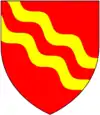 | ||
| 1245-57[23] | Richard Blund |  | ||
| 1258-80[24] | Walter Branscombe | 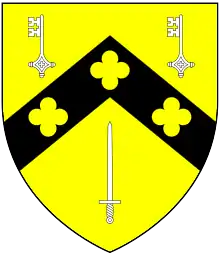 | ||
| 1280-91[25] | Peter Quinel | 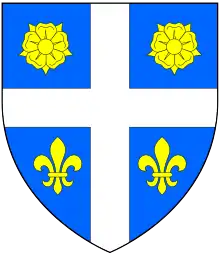 | ||
| 1291-1307[26] | Thomas Bitton | |||
| 1308-1326 | Walter de Stapledon |  | ||
| 1326-27 | James Berkeley |  | ||
| 1327[27] | John Godeley | |||
| 1327-69 | John Grandisson | _BishopOfExeter.svg.png.webp) | ||
| 1370-94[28] | Thomas de Brantingham | 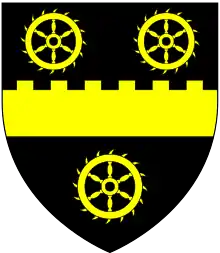 | ||
| 1395-1419 | Edmund Stafford | 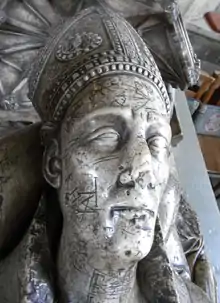 | 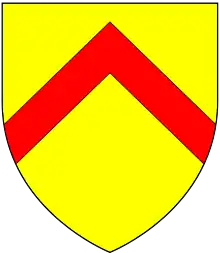 | |
| 1419[29] | John Catterick | |||
| 1420-55[30] | Edmund Lacey |  | ||
| 1455-56[31] | John Hales | |||
| 1458-65[32] | George Neville |  | ||
| 1465-78 | John Booth |  | ||
| 1478-87[33] | Peter Courtenay | 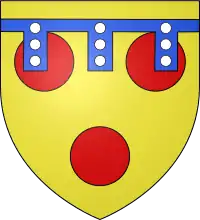 | ||
| 1487-92[34] | Richard Foxe | 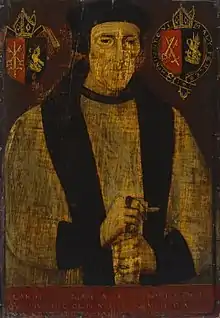 | 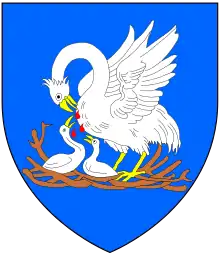 | |
| 1493-95[35] | Oliver King | |||
| 1496-1502[36] | Richard Redman | |||
| 1502-4[37] | John Arundel |  | ||
| 1505-19 | Hugh Oldham | 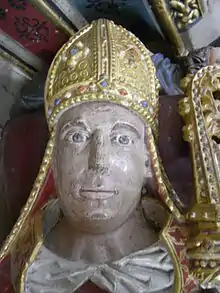 |  | |
During the Reformation
| Dates of reign | Name | Portrait | Arms |
|---|---|---|---|
| 1519-51[38][17][39][40] | John Vesey |  | |
| 1551-53[41][17][39][40] | Myles Coverdale |  | 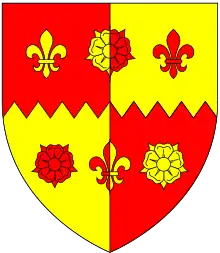 |
| 1553-54[42][17][39][40] | John Vesey |  | |
| 1555-60[17][39][40] | James Turberville | 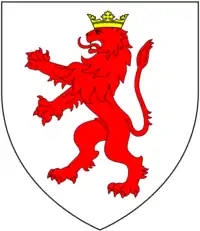 | |
Post-Reformation
| Post-Reformation Bishops of Exeter | |||
|---|---|---|---|
| From | Until | Incumbent | Notes |
| 1560 | 1571 |  William Alley William Alley |
Also recorded as William Alleyn |
| 1571 | 1578 |  William Bradbridge William Bradbridge |
|
| 1579 | 1594 |  John Woolton John Woolton |
|
| 1595 | 1597 |  Gervase Babington Gervase Babington |
Translated to Worcester |
| 1598 | 1621 |  William Cotton William Cotton |
|
| 1621 | 1626 |  Valentine Cary Valentine Cary |
|
| 1627 | 1641 |  Joseph Hall Joseph Hall |
Translated to Norwich |
| 1642 | 1659 | 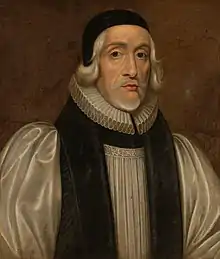 Ralph Brownrigg Ralph Brownrigg |
|
| 1660 | 1662 | 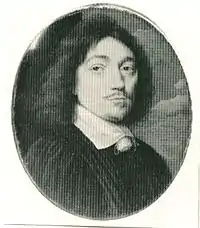 John Gauden John Gauden |
Translated to Worcester |
| 1662 | 1667 | 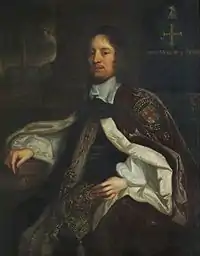 Seth Ward Seth Ward |
Translated to Salisbury |
| 1667 | 1676 |  Anthony Sparrow Anthony Sparrow |
Translated to Norwich |
| 1676 | 1688 | 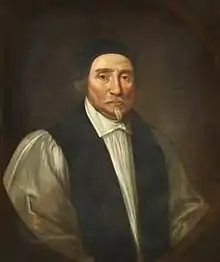 Thomas Lamplugh Thomas Lamplugh |
Translated to York |
| 1689 | 1707 | 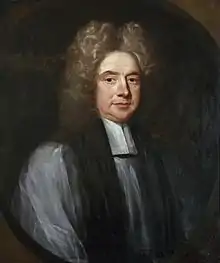 Sir Jonathan Trelawny, Bt. Sir Jonathan Trelawny, Bt. |
Translated from Bristol; later translated to Winchester |
| 1708 | 1716 | 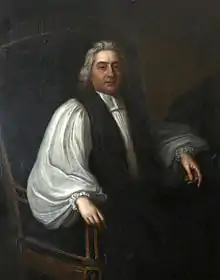 Ofspring Blackall Ofspring Blackall |
|
| 1717 | 1724 | %252C_Archbishop_of_York.jpeg.webp) Lancelot Blackburne Lancelot Blackburne |
Translated to York |
| 1724 | 1742 | 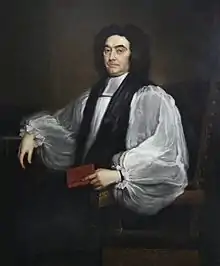 Stephen Weston Stephen Weston |
|
| 1742 | 1746 |  Nicholas Clagett Nicholas Clagett |
Translated from St David's |
| 1747 | 1762 | 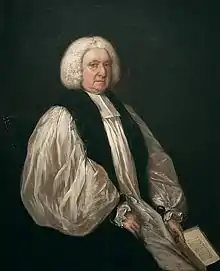 George Lavington George Lavington |
|
| 1762 | 1777 |  Frederick Keppel Frederick Keppel |
|
| 1778 | 1792 |  John Ross John Ross |
|
| 1792[43] | 1796 |  William Buller William Buller |
|
| 1797 | 1803 |  Reginald Courtenay Reginald Courtenay |
Translated from Bristol |
| 1803 | 1807 |  John Fisher John Fisher |
Translated to Salisbury |
| 1807 | 1820 |  George Pelham George Pelham |
Translated from Bristol; later translated to Lincoln |
| 1820 | 1830 |  William Carey William Carey |
Translated to St Asaph |
| 1830 |  Christopher Bethell Christopher Bethell |
Translated from Gloucester; later translated to Bangor | |
| 1831 | 1869 | 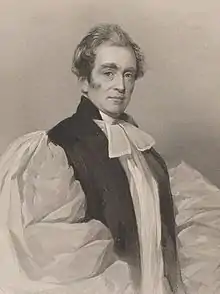 Henry Phillpotts Henry Phillpotts |
|
| 1869 | 1885 |  Frederick Temple Frederick Temple |
Translated to London |
| 1885 | 1900 | 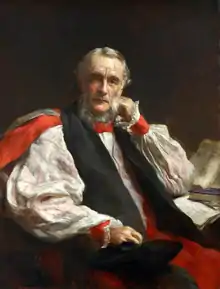 Edward Bickersteth Edward Bickersteth |
|
| 1901 | 1903 |  Herbert Edward Ryle Herbert Edward Ryle |
Translated to Winchester |
| 1903 | 1916 |  Archibald Robertson Archibald Robertson |
|
| 1916 | 1936 |  Lord William Cecil Lord William Cecil |
|
| 1936 | 1948 |  Charles Curzon Charles Curzon |
Translated from Stepney |
| 1949 | 1973 |  Robert Mortimer Robert Mortimer |
|
| 1973 | 1985 |  Eric Mercer Eric Mercer | Translated from Birkenhead |
| 1985 | 1999 |  Hewlett Thompson Hewlett Thompson |
Translated from Willesden |
| 1999 | 2013[44] |  Michael Langrish Michael Langrish |
Translated from Birkenhead |
| 2014 | present | .jpg.webp) Robert Atwell Robert Atwell |
[3] Translated from Stockport |
| Source(s):[17][39] | |||
Assistant bishops
Among those who have served as assistant bishops of the diocese have been:
- mid-1860s: James Chapman, Rector of Wootton Courtenay and former Bishop of Colombo[45][46][47]
- While he was Rector of Down St Mary (1897–1903), Kestell Kestell-Cornish, retired Bishop of Madagascar, sometimes assisted the bishop[48]
- 1947 – 1952 (ret.): Rocksborough Smith, Rector of Lapford and former Bishop of Algoma[49]
See also
References
- Debrett's Peerage, 1968, p.432
- Crockford's Clerical Directory, 100th edition, (2007), Church House Publishing. ISBN 978-0-7151-1030-0.
- Diocese of Exeter – Election of new Bishop of Exeter formally confirmed (Accessed 9 May 2014)
- "Robert Ronald Atwell". Crockford's Clerical Directory (online ed.). Church House Publishing. Retrieved 25 June 2017.
- Risdon, Tristram (d.1640), Survey of Devon, 1811 edition, London, 1811, with 1810 Additions, p.321
- Pevsner, Nikolaus & Cherry, Bridget, The Buildings of England: Devon, London, 2004, p.184
- Heritage Gateway, "Bishop's Palace at Court Farm, Bishop's Tawton"
- Risdon, 1810 Additions, p.427
- The manor was conveyed by Bishop Veysey, in 1550, to Lord John Russell, afterwards Earl of Bedford, at the request of the King, together with other manors (White's Devonshire Directory of 1850)
- John Marius Wilson's Imperial Gazetteer of England and Wales, 1870-72,
- John Marius Wilson's Imperial Gazetteer of England and Wales, 1870-72
- Chattaway, Joseph, An Historical Sketch of the Danmonii: Or Ancient Inhabitants of Devonshire, 1830, p.79
- http://www.britishlistedbuildings.co.uk/en-443618-copplestone-cross-copplestone-devon
- Crediton Festival 2009 Archived 21 May 2009 at the Wayback Machine. Retrieved on 5 June 2008.
- Exeter: Ecclesiastical History. Retrieved on 5 June 2008.
- Joseph Thomas (1 January 2010). The Universal Dictionary of Biography and Mythology. Cosimo, Inc. p. 93. ISBN 978-1-61640-069-9.
- "Historical successions: Exeter (including precussor offices)". Crockford's Clerical Directory. Retrieved 18 July 2012.
- Fryde, E. B.; Greenway, D. E.; Porter, S.; Roy, I. (1986). Handbook of British Chronology (3rd, revised ed.). Cambridge: Cambridge University Press. p. 287. ISBN 0-521-56350-X.
- Izacke, Richard (c.1624–1698), (improved and continued to the year 1724 by Samuel Izacke), Remarkable Antiquities of the City of Exeter, 3rd Edition, London, 1731, A Perfect Catalogue of all the Bishops of this Church ... together with the Coats of Armory and Mottoes Described, pp.25-50
- The first to unite and transfer the Sees of Crediton and Cornwall to Exeter
- See vacant due to Pope Innocent III's interdict against King John's realms
- Aliter William Brewer
- Aliter Richard Blundy
- Aliter Walter Bronescombe
- Aliter Peter de Quivel or Quivil
- Aliter Thomas de Bytton
- Also recorded as John Godele. Elected, but quashed
- Aliter Thomas Brantyngham
- Aliter John Ketterick, translated from Lichfield
- Also recorded as Edmund Lacy. Translated from Hereford
- Appointed, but resigned before consecration
- Translated to York
- Translated to Winchester
- Translated to Bath and Wells
- Translated to Bath and Wells
- Translated from St Asaph; later translated to Ely
- Translated from Lichfield
- (deposed, Roman Catholic)
- Fryde, E. B.; Greenway, D. E.; Porter, S.; Roy, I. (1986). Handbook of British Chronology (Third Edition, revised ed.). Cambridge: Cambridge University Press. pp. 246–248. ISBN 0-521-56350-X.
- Horn, J. M. (1962). "Bishops of Exeter". Fasti Ecclesiae Anglicanae 1300–1541: Volume 9: Exeter Diocese. British History Online. pp. 1–3.
- Protestant
- recovered, Roman Catholic)
- "No. 13457". The London Gazette. 8 September 1792. p. 694.
- BBC News – Bishop Langrish retires from office (Accessed 1 July 2013)
- "Church News". Church Times (#100). 31 December 1864. p. 419. ISSN 0009-658X. Retrieved 26 December 2019 – via UK Press Online archives.
- "Consecration of St Peter's Church, Newlyn, Penzance". Church Times (#174). 2 June 1866. p. 175. ISSN 0009-658X. Retrieved 26 December 2019 – via UK Press Online archives.
- "Church News". Church Times (#243). 28 September 1867. p. 337. ISSN 0009-658X. Retrieved 26 December 2019 – via UK Press Online archives.
- "Clerical obituary". Church Times (#2407). 12 March 1909. p. 332. ISSN 0009-658X. Retrieved 14 March 2020 – via UK Press Online archives.
- "Smith, Rocksborough Remington". Who's Who. ukwhoswho.com. A & C Black, an imprint of Bloomsbury Publishing plc. (subscription or UK public library membership required)
Sources
- Some text adapted from Catholic Encyclopaedia, 1908.
